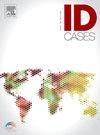Aural myiasis caused by Lucilia sericata in an asymptomatic patient with dementia
IF 1.1
Q4 INFECTIOUS DISEASES
引用次数: 0
Abstract
This study amied to elucidate the case of an older patient suffering from aural myiasis caused by Lucilia sericata. An 81-year-old female patient with a history of middle ear surgery and dementia presented with bleeding in her right ear and visible worms. Upon initial examination, a larva was found crawling on the right auricle. Further examination revealed numerous larvae, purulent otorrhea, and active bleeding in the external auditory canal and mastoid cavity. All larvae were successfully removed with ear irrigation. The patient was diagnosed with otitis media and treated with antibiotic ear drops, resulting in significant clinical improvement. The larvae were later identified morphologically as Lucilia sericata, a species of Calliphoridae. This case highlights the potential for aural myiasis in elderly patients with dementia and otitis media, who may be at increased risk for the condition.
无症状痴呆患者由丝光绿蝇引起的耳蝇病
本研究旨在阐明一例老年患者由丝光绿蝇引起的耳蝇病。81岁女性,中耳手术史,痴呆,右耳出血,可见虫。经初步检查,发现一只幼虫在右耳廓上爬行。进一步检查发现大量幼虫,化脓性耳漏,外耳道和乳突腔活动性出血。用耳灌洗法成功去除所有幼虫。患者被诊断为中耳炎,并接受抗生素滴耳液治疗,临床明显改善。幼虫后来被形态学鉴定为丝光Lucilia sericata, Calliphoridae的一种。该病例突出了老年痴呆和中耳炎患者患耳蝇病的可能性,这些患者患此病的风险可能增加。
本文章由计算机程序翻译,如有差异,请以英文原文为准。
求助全文
约1分钟内获得全文
求助全文

 求助内容:
求助内容: 应助结果提醒方式:
应助结果提醒方式:


